No-code platforms like Webflow and Bubble are empowering users to create impressive websites and applications without needing to write a single line of code. However, selecting the ideal no-code platform can be a challenge, particularly for those unfamiliar with the strengths and weaknesses of each option.
This comprehensive guide dives into a detailed comparison of Bubble and Webflow. We'll objectively assess crucial factors like pricing, core functionalities, design flexibility, and the learning curve involved. By providing a balanced analysis, we aim to equip you with a clear understanding of which platform – Bubble or Webflow – best aligns with your specific needs and goals.
What is Bubble?
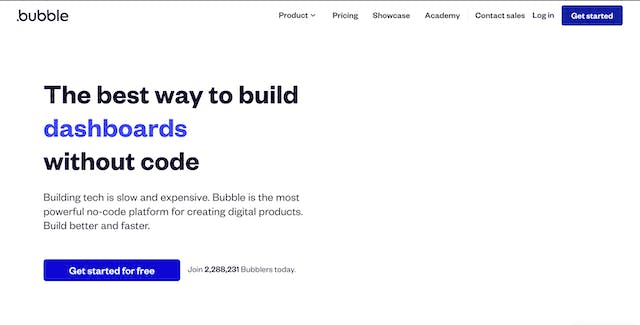
Bubble is a no-code platform that allows users to build custom web apps and websites. Bubble’s drag-and-drop editor will let you create apps and sites from scratch without having to write a single line of code.
Bubble is popular for its extensive range of plugins and integrations which you can add to your project with the click of a button. Additionally, you can build complex workflows to get your app or site running as smoothly as possible, no matter its scale.
Fun fact: you can have a go at editing with Bubble on their website – move things around on their landing page and customize as you please!
Want to find out more about Bubble? Check out our article on Bubble pros and cons.
What is Webflow No-Code?
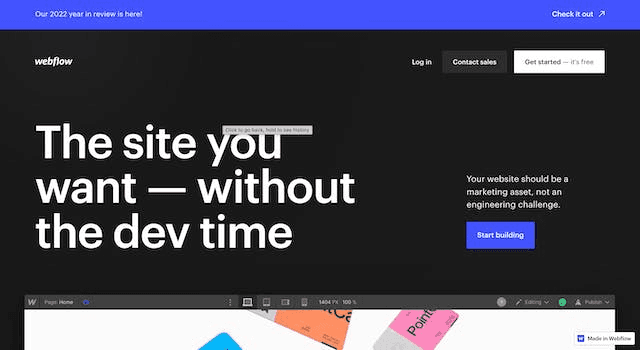
Webflow is a no-code platform for building websites, with a focus on having complete control over the design process. It is most known for its ability to build CMSs (Content Management Systems) with and for its interactive drag-and-drop editor.
Our favorite thing about Webflow is that it offers lots of powerful design features for a relatively affordable price. It is also great for eCommerce with custom animations and interactions, though it’s important to note that it will take you a while to climb Webflow’s learning curve.
Webflow vs Bubble Platform Comparison
When it comes to building web apps without code, two popular options are Webflow and Bubble. Both are no-code website builders that allow users to create responsive websites without the need for coding knowledge. However, there are some key differences between the two platforms that can help you decide which one is right for your needs.
Key Differences:
a) Webflow is primarily a design and development tool that allows users to create visually stunning websites with animations, interactions, and responsive design. Bubble, on the other hand, is a no-code platform that focuses on building complex web applications without code.
b) Webflow offers a free plan, which is ideal for small projects or personal websites. Bubble, however, does not offer a free plan, but it provides a 30-day free trial for users to test the platform.
c) Webflow provides users with more control over the design and layout of their website, making it ideal for designers and developers who want to create custom designs. Bubble, on the other hand, offers a more limited design palette but provides more advanced features for building complex web applications.
d) Webflow requires users to write code for custom functionality, while Bubble provides a drag-and-drop interface that allows users to build complex applications without writing any code.
e) Webflow is a SaaS (Software as a Service) platform, which means that users have to pay a monthly or yearly subscription fee to use its services. Bubble, on the other hand, offers a one-time payment plan for its users.
Bubble.io:
Bubble is a no-code platform that allows users to build complex web applications without writing any code. It provides a drag-and-drop interface that allows users to create responsive websites, web applications, and even mobile apps. Bubble offers a 30-day free trial, and its pricing plans start at $25/month.
Key Features of Bubble:
a) Drag-and-drop interface: Bubble provides a user-friendly interface that allows users to build web applications without writing any code.
b) Responsive design: Bubble's responsive design features ensure that websites and applications look great on any device.
c) Advanced functionality: Bubble provides advanced features such as user authentication, database integration, and webhooks, making it ideal for building complex web applications.
d) Customizable: Bubble allows users to customize their website's design and layout using CSS and JavaScript.
Webflow:
Webflow is a design and development tool that allows users to create visually stunning websites with animations, interactions, and responsive design. Webflow offers a free plan, as well as several paid plans that cater to different users' needs.
Key Features of Webflow:
a) Design and development: Webflow provides users with a powerful design and development tool that allows them to create custom designs and animations.
b) Interactions: Webflow's interaction design features allow users to create interactive elements such as scrolling effects, animations, and mouse-overs.
c) Responsive design: Webflow's responsive design features ensure that websites look great on any device.
d) Customizable: Webflow provides users with full control over the design and layout of their website, making it ideal for designers and developers who want to create custom designs.

Bubble vs Webflow Features
Let’s cut to the chase here – Bubble has an entirely different set of features compared to Webflow.
Bubble’s features are solid enough to offer prototypes, web apps, and software building. On the other hand, Webflow is more suitable for websites and marketing digital products only.
All in all, Bubble offers more features than Webflow. You’ll be able to choose between features like:
Chats
Built-in analytics
Multi-lingual localization
Up to 40 collaborators at a time
Customized forms
Stripe and Braintree payments
And more.
Webflow, on the other hand, is more focused on features for website customization and marketing development. We will say, however, that its extensive library of templates makes up for its lack of features with more than 1000 templates to choose from.
Bubble vs Webflow Pricing
When it comes to no-code platforms, pricing can sometimes be a deal breaker. There are some pretty affordable options out there, but some other tools represent a huge cost. Of course, the cost of no-code development is still significantly lower than traditional development. You can hire a no-code developer for so much less than a traditional developer.
Fortunately, both Webflow and Bubble offer the nifty option of not paying for the development of your first project. That means that as long as you’re trying things out, without any time limit whatsoever, you’ll be able to use both platforms for free. No committing to anything or having to make a decision before you know for sure which is better suited to your needs. However, you’ll have to pay for the plan of your choice on both platforms before your app/website goes live.
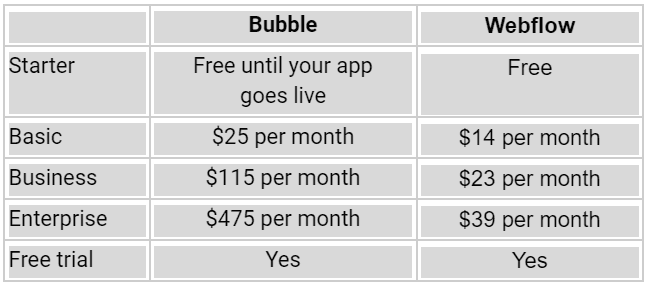
Webflow and Bubble both provide decent pricing options, though whether these plans are right for you will depend on your needs and budget. We’ll leave it up to you to decide!
Bubble vs Webflow: Design Freedom and Customisation
If you’re focused on having control over your app or website’s design, Webflow will be a better option. It’s a favorite among proficient designers because of the design freedom and flexibility it offers.
That’s not to say that Bubble doesn’t offer much customization, it’s just better known for its backend functionality, which makes it great for creating solid, scalable apps.
You might also find it difficult to achieve a high level of design with Bubble if you’re a beginner, because of its learning curve which we’ll discuss a bit later on. Bubble experts have no problem at all creating gorgeous, on-brand designs, but Webflow is definitely more recommended for no-code beginners. Here are some examples of Bubble apps you can browse through.
When we build with Bubble, we always like to design on Figma first with our team of brilliant Figma designers.
Bubble vs Webflow: Learning Curve
In our opinion, both Bubble and Webflow are overall quite intuitive. Additionally, there are lots of tutorials, blog posts, and courses available to help you navigate both platforms. Webflow, especially, has the Webflow University which is a bible brimming with resources.
In all honesty, though, it will most likely be more difficult to understand how Bubble works will all the added complexity of workflows, database systems, and user management. That’s why we often build projects for those who don't have the time or the patience to go through the learning curve. If you feel overwhelmed, feel free to book a call with us!
Though Webflow does require a basic knowledge of HTML and CSS, it offers a learn-as-you-go approach which will allow you to get going fast. You should be able to use it without any prior experience in coding and development.
Bubble vs Webflow Community, Resources, and Support

When it comes to no-code platforms, community, and support can be really important. Webflow wins this round hands down, with a full-fledged online Webflow University: videos, tutorials, eBooks, and pdfs presented with a wonderfully intuitive approach. Because they’ve made learning how to use the platform so user-friendly, getting to know Webflow is actually pretty effortless.
The Bubble Academy is quite good too, though it’s not as much of a concept compared to Webflow’s. It walks you through exactly how to use the platform and gives you a solid overview.
On the support side, both platforms have reactive and helpful customer service. You can submit a ticket on Bubble even if you’re not a paid user, and support options will grow as you go up into the pricier plans. Webflow’s support options are slightly less straightforward, but you can still email their team with any query.
Both Bubble and Webflow have a strong community of users to guide and support you with your projects. Bubble’s user-based community has thousands of active members who help each other fix issues and solve problems.
Bubble vs Webflow Integrations and Plugins
Depending on how complex your needs are, you may or may not be in the market for a tool with extensive integration options. Both platforms are excellent at offering widespread APIs and integrations. Bubble for example has a huge database of conditional situations connecting to APIs for you to significantly maximise your project’s potential. Webflow has slightly less, with most integrations flowing to Facebook and Twitter, and other eCommerce plugins.
It’s important to bear in mind that you’ll have to go for the more expensive monthly plans if you want to use plugins and integrations. Interested in checking out the integrations that fit into your workflow? Here is a quick comparison of both platforms’ APIs.

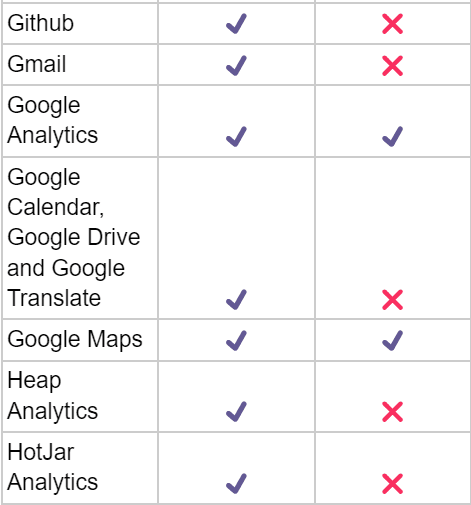
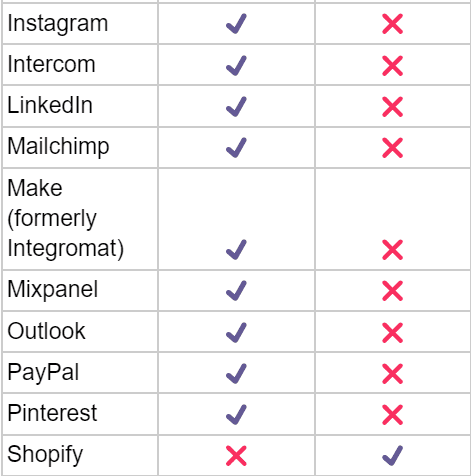
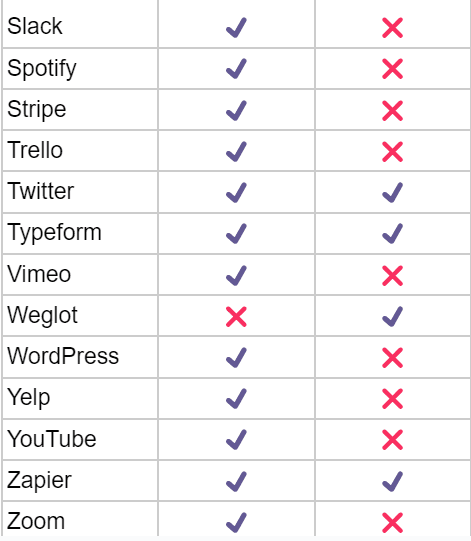

Bubble vs Webflow CMS (Content Management System)
A lot of Webflow’s users were initially attracted by the impressively complete CMS (Content Management System) that the platform offers. It will allow you to effortlessly create, publish and manage blogs and other types of content.
However, you’ll only be able to use Webflow’s CMS if you purchase one of the higher plans, at $23 per month (around £19).
Bubble’s CMS abilities, on the other hand, are less efficient. There’s the option to use what are called “headless CMSs” that you can connect to Bubble via APIs – Ghost, Contentful, Strapi, Preppr, and more.
The thing is, none of these are fully compatible with the way Bubble displays data, which makes using them somewhat tricky. You’ll need to move things about and make a few changes before your content is fully optimized for search engines. You may also need to add some HTML elements with custom CSS in order to display rich text at times. Yeah, not very beginner-friendly, and is a bit of a hassle.
Still, with Bubble’s headless options, you could be able to access a more complete level of CRM compared to Webflow’s native system, because of how customizable things will be. If you’re after simplicity more than complexity, Webflow will be just right though. You’ll be able to easily manage your content by inviting teammates and clients to upload content with a well-defined user hierarchy.
Bubble vs Webflow for SEO

When it comes to SEO, Webflow is king. Not only does the platform automatically format content to be easily scannable by search engines, but it also offers plenty of in-depth SEO features. SEO geeks brace yourself – these are some of Webflow’s SEO functions:
Adding and editing schema markup
Meta titles and meta descriptions
Indexing and sitemap controls
Robust 301 redirects management
Simple image alt tag editing
Semantic code
Fast and secure hosting
It is slightly harder to navigate SEO with Bubble, but still completely possible. For example, it’s not as straightforward as with Webflow to nail your site’s metadata when it comes to dynamic content and pages. You’ll need to upload custom javascript or store your content’s metadata in Bubble’s database to set the metadata for your pages.
The Bottom Line: Between Webflow and Bubble, Which Template Should You Choose?
Ah, this is a tricky one. Bubble and Webflow both have their own very specific set of flaws and advantages, which makes it difficult to assess which is better. What we can say for sure is that Bubble is turned more towards back-end features, whereas Webflow is more concentrated on front-end design.
Bubble has more complex features to offer, which will be advantageous if you’re looking for a scalable solution. Webflow has a great CMS option, useful for those who are looking to build out blogs for lead generation. Bubble’s plugins are more complete, and Webflow’s learning curve is less steep. Lastly, Bubble offers slightly more design freedom and flexibility compared to Webflow.
All in all, it all really comes down to what you’re looking for in a no-code platform. It might be a good idea to think about your main criteria, which could look something like:
Budget – how far can you stretch your investment?
CMS – will you need to manage content easily?
Design freedom – does your project require a lot of flexibility when it comes to design?
Plugins and integrations – will you need to set up a complex workflow?
Support and community – is this something important to you?
SEO – are you looking for a platform that makes SEO easy?
Features – which features do you need the most?
In our experience here at Goodspeed Studio, the hardest part of bringing your no-code project to life is going from idea to finished product. It’s not uncommon to have trouble translating your thoughts into an actual app or website, whichever platform you go for.
That’s why we help people get their dream apps and websites with Bubble. We’ll help you take your ideas to prototypes in a fraction of the time of traditional development – have a read about our Bubble developers and book a call with us today to get the ball rolling!

Conclusion
Harish Malhi
Founder of Goodspeed
Harish Malhi is the founder of Goodspeed, one of the top-rated Bubble agencies globally and winner of Bubble’s Agency of the Year award in 2024. He left Google to launch his first app, Diaspo, built entirely on Bubble, which gained press coverage from the BBC, ITV and more. Since then, he has helped ship over 200 products using Bubble, Framer, n8n and more - from internal tools to full-scale SaaS platforms. Harish now leads a team that helps founders and operators replace clunky workflows with fast, flexible software without writing a line of code.
Frequently Asked Questions (FAQs)
Is Webflow easier than Bubble?
Webflow is slightly easier to learn compared to Bubble, but it does have limitations like less design freedom and flexibility.
What's better than Webflow?
The best alternative to Webflow is Bubble. It allows for the seamless development of apps and sites with powerful features without having to write a single line of code.
Is Bubble the best no-code builder?
In our opinion, Bubble is the best no-code builder on the market. That's because it allows you to build anything (apps, sites, software) without using code.
Can you use Webflow and Bubble together?
You can use Webflow and Bubble together side by side to make the most of their powerful features. Webflow's CMS coupled with Bubble's backend functionality is a winning team.
What are the disadvantages of Webflow?
Though Webflow is a favorite among the no-code community, it has a few limitations it's important to be aware of. It lacks backend functionality and plugin options.
Do professionals use Webflow?
Webflow is used by professional web designers because of its powerful features and great freedom of design.
Why is Webflow so hard?
Webflow utilizes a pretty unique visual coding language that you might have a hard time getting used to. It is considered to be one of the hardest no-code platforms to learn.









